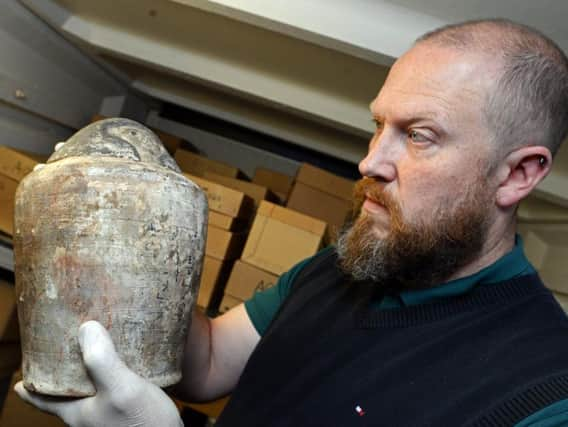What are the items you can't see at Doncaster Museum?


Generations of Doncaster youngsters have grown up with fond memories of visiting Doncaster Museum's growling brown bear, its Doncaster-built 1914 Cheswold car, and its prehistoric Ichthyosaurus fossil skeleton.
The building on Chequer Road has seen millions pass through its doors since it first opened in 1964.
Advertisement
Hide AdAdvertisement
Hide AdBut for all the museum's wealth of artetacts and history, for every item on display, there is one hidden away in the museums service's storehouse.
Some of the items are kept out of sight because there is not enough space for them. Others cannot be put on show because they are so fragile.
But many of them help tell a tale of Doncaster's history, and indeed that of the world.
The Free Press was given a rare view of some of these hidden treasures - and experts hope that they some of them may go back into the public gaze in the future.
Advertisement
Hide AdAdvertisement
Hide AdIt is possible that some may be go on exhibition in the planned new museum and library building, which is due to opens in 2020.
Curator of human history at Heritage Doncaster, Peter Robinson, is hoping to be able to rotate the items on show more easily at the new museum when it opens on Waterdale, potentially meaning some items currently hidden away could be put on display, so that people can see different exhibits if they visit the museum on two different dates.
And he also believes that work which will see the current Chequer Road site into a museum store could mean that members of the public would find it easier to make pre-arranged visits to see parts of the stored collections.
Mr Robinson said: "Just because things are in store does not mean people do not see them. They are often used by the reseach community and academia. What the public sees has to be researched, and that work is always going on.
Advertisement
Hide AdAdvertisement
Hide Ad"In the new museum display area and archives, we think it will be a more flexible display space. We will take loan objects, and rotate collections more frequently, working with the community to find out what they want to view.
"And part of the plan is to have a more accessible research and volunteer facility. At present, some items are in areas that are not set up for accessibility. Remodelling this will create a facility which allows people to access collections more easily, like Leeds Discovery Centre where people can come in by appointment and see things."
There is a plan to create a group of volunteers to help people access collections.
But the service's current storage areas are not designed for accessibility.
Advertisement
Hide AdAdvertisement
Hide AdDuring our visit, we were asked to wear hard hats to avoid injury from low structural beams.
But we did get the chance to see historic items dating back centuries.
The experts wear gloves to handle the items. Partly, that is to protect the exhibits from grease on the staff member's hands.
But it is also to protect the handler. Some items have been treated with chemicals. It also protects them from items such as poison tipped darts in the collection.
Advertisement
Hide AdAdvertisement
Hide AdIn the next few weeks we will focus on items currently hidden away, starting today with a jar from ancient Egypt.
Canopic jar - Ancient Egypt
In 1926, a well-known Doncaster family handed a piece of ancient Egyption history to Doncaster museum, more than 2,000 years after it had been made.
The canopic jar was donated in 1926 by the family of a local collector, a Mr Davies-Cooke, dating back from 800BC.
This particular Canopic Jar contained the dead person's liver. The face and cartouche on the jar relate to the God Imseti (God of the South) who protected the Liver. There are another three jars that complete the set of four, dedicated to different gods and which would have contained different body parts.
Advertisement
Hide AdAdvertisement
Hide AdThey carried inscriptions that were intended to protect the body parts and help the individual in the afterlife.
The item is part of a number of items belonging to the Cooke family, who lived at Wheatley Hall, a large house in Wheatley, which was on the site later occupied by ICI. The hall was demolished in the 1930s.
The antiquities collection does not get aired very often because it does not fit well with the story of Doncaster the museum tells, which largely focuses on the borough's own heritage.
However, the jar was recently put on public display - but outside the borough.
Advertisement
Hide AdAdvertisement
Hide AdIt was an item which was loaned out to Barnsley museums for an exhibtion on ancient Egypt in 2017, designed and guest curated by Professor Joann Fletcher, the Barnsley-born award-winning Egyptologist, The exhibition at Experience Barnsley brought together artefacts, paintings and photographs from the ancient land of Egypt..
Each piece had been carefully selected by Joann from collections across the county to tell the story of the relationship between ancient Egypt and Yorkshire.
Curator of human history at Heritage Doncaster, Peter Robinson, said: "Prof Fletcher borrowed some of our collection that she felt had quality or importance."